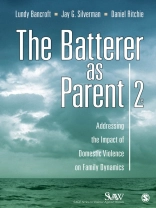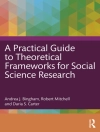Moving beyond the narrow clinical perspective sometimes applied to viewing the emotional and developmental risks to battered children,
The Batterer as Parent:
Addressing the Impact of Domestic Violence on Family Dynamics,
Second Edition offers a view that takes into account the complex ways in which a batterer′s abusive and controlling behaviors are woven into the fabric of daily life. This book is a guide for therapists, child protective workers, family and juvenile court personnel, and other human service providers in addressing the complex impact that batterers—specifically, male batterers of a domestic partner when there are children in the household—have on family functioning. In addition to providing an understanding of batterers as parents and family members, the book also supplies clearly delineated approaches to such practice issues as assessing risk to children (including perpetrating incest), parenting issues in child custody and visitation evaluation, and impact on children′s therapeutic process and family functioning in child protective practice.
Tabela de Conteúdo
Foreword
Preface
1. The Battering Problem
Defining Batterers
Characteristics of Batterers
Misconceptions About Batterers
Summary
2. Power Parenting: The Batterer′s Style With Children
Typical Characteristics of Batterers as Parents
Effects on Children of Exposure to Domestic Violence
Child Abuse
The Batterer as Role Model
Children′s Outlook on the Batterer
Summary
3. Shock Waves: The Batterer′s Impact on the Home
Undermining of the Mother′s Authority
Effects on Mother-Child Relationships
Use of Children as Weapons Against the Mother
The Batterer′s Impact on Other Aspects of Family Functioning
Resilience in Mother-Child and in Sibling Relationships
Summary
4. The Batterer as Incest Perpetrator
Review of Studies
The Predatory Child Molester Versus the Incest Perpetrator
Shared Tactics of Batterers and Incest Perpetrators
Shared Attitudes of Batterers and Incest Perpetrators
Implications of the Overlap for Professional Response
Sexual Abuse Allegations in Custody and Visitation Disputes
Summary
5. Impeding Recovery: The Batterer as Parent Postseparation
Creating a Context for Children′s Healing
Batterers′ Postseparation Conduct With Children
Batterers′ Motivations for Seeking Custody or Increased Visitation
Batterers′ Advantages in Custody Disputes
Batterers′ Tactics in Custody and Visitation Disputes
Effects on Children of Custody Litigation
Summary
6. The Mismeasure of Batterers as Parents: A Critique of Prevailing Theories and Assessment
Influential Theories of Divorce
The Use of a Domestic Violence Typology to Assess Risk to Children
Risk to Children: The Overlooked Implications of Johnston, Campbell, and Roseby′s Own Observations
Summary
7. Supporting Recovery: Assessing Risk to Children From Batterers and Structuring Visitation
Sources of Risk to Children From Unsupervised Contact With Batterers
A Guide to Assessing Risk to Children From Batterers
Structuring Custody and Visitation
Summary
8. Is It Real? Assessing and Fostering Change in Batterers as Parents
Steps to Change in Batterers
Misconceptions Regarding Change in Batterers
Evaluating Change in Batterers as Parents
Creating a Context for Change
Summary
9. Improving Community Responses to the Parenting of Batterers
Children′s Advocates, Child and Family Therapists, and Programs for Children Exposed to Domestic Violence
Custody Evaluators
Family Courts
Child Protection Systems and Courts With Protective Jurisdiction
Parent Trainers
Psychological Evaluators
Batterer Programs and Fatherhood Programs
Battered Women′s Programs
Supervised Visitation Centers
Family Lawyers and Bar Associations
Police Departments
Researchers
Summary
References
Index
About the Authors
Sobre o autor
Jay Silverman is Professor of Medicine and Global Public Health at the University of California at San Diego. He is a developmental psychologist with 20 years of experience in domestic violence, including direct counseling experience with hundreds of men who batter. He has led multiple, large-scale international and domestic research programs on issues of gender-based violence against women and girls; this work has resulted in more than 100 peer-reviewed studies. His research has included examinations of the social contextual influences on the etiology of male-perpetrated partner violence, the nature and health consequences of adolescent dating violence, history of child abuse among men who perpetrate partner violence, judicial behavior and the experiences of battered mothers in child custody cases, the role of partner violence in men’s transmission of HIV to their female partners, the nature and HIV risks associated with trafficking of women and girls for sexual exploitation, and the roles of partner violence in unintended and teen pregnancy, coercion regarding abortion, pregnancy loss, and infant and child morbidity and mortality.












